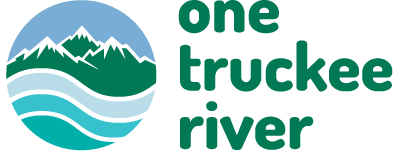Introducing: The River-Friendly Living Demonstration Garden at Lake Park
Installed in April 2024, the River-Friendly Living Demonstration Garden showcases landscaping features like Buffer Strips and Rain Gardens (also known as Mini-Meadows) that prevent runoff, protect the Truckee River, and include native and pollinator-friendly plants with so many benefits to our Northern Nevada environment. We encourage you to visit Reno’s Lake Park (at 40 Coleman Drive) to explore new ideas to improve your home garden – saving you time and money while beautifying your property.
Checking out the Demonstration Garden is a great way to get a sense for what River-Friendly Yards landscaping is about and how it feels. Check these plants and garden features out, enjoy them, and consider which ones would make the best additions to your home garden.
Have you visited Lake Park? Located in Northwest Reno, it’s a beautiful spot to explore. Follow the pathway around the small lake, check out the recently-planted native species, note the floating wetlands in the pond, keep an eye out for birds, and (if you have kids in tow) enjoy the shaded playground. As you circle the lake, informational signs will teach you about the plants and landscaping features you’re observing.
Here's what’s highlighted at the River-Friendly Living Demonstration Garden:
Best Practices for River-Friendly Yards
From installing smart irrigation systems and compost bins, to picking up pet waste and using commercial car washes instead of your driveway, there’s so many quick, easy choices we can make at home that have huge impacts on the Truckee River Watershed. A few of our top recommendations overall are covered on our River-Friendly Living page and our River-Friendly Yards practices are displayed through the Demonstration Garden and educational signage at Lake Park.
Top practices include:
1. Buffer Strips are water-wise perennial planting areas between your lawn and the sidewalk. These strips keep sprinkler overspray from running onto the sidewalk and down the storm drain, reducing potential for fertilizers and pesticides to flow into the Truckee River. They also add great color and variety to your landscaping! At the Demonstration Garden, we’ve highlighted several native plants that could look stunning in the space between your driveway and lawn.
2. Rain Gardens / Mini-Meadows - Here in the Truckee Meadows, we only receive 8 inches of rainfall per year! A rain garden, also known as a mini-meadow, is one of our favorite ways to make the most of it – while providing healthy habitats for neighborhood wildlife and absorbing runoff.
A rain garden is a small depression designed to capture rainwater flowing off hardscapes (like driveways and rooftops) and soak it into the ground. When it rains, these surfaces pick up fertilizers, oils, pesticides, dirt, bacteria, and other pollutants, often pushing them down storm drains and into the Truckee River
Alternatively, rain gardens are filled with vegetation that appreciate the occasional seasonal flooding and allow nutrients and fertilizers to stay where plants will use them. We’ve installed a rain garden at the River-Friendly Living Demonstration Garden, along with information about adding a smaller version to your yard.
3. Floating Wetlands - While it’s unlikely you’ll have a need for wetlands plants in your yard, Lake Park is a unique place to learn about them close to home! Wetlands are vegetated areas where water covers the soil, seasonally or throughout the year, with submerged root systems helping capture nutrients, remove common water pollutants, and provide a safe habitat and nesting area for fish, waterbirds, and other wildlife. When you visit Lake Park, you’ll notice 3 floating wetlands the City of Reno installed, as well as beneficial wetlands plants circling the pond’s shoreline.
4. Lake Park’s History - Additional signage at Lake Park walks you through the area’s past. Long before Europeans settled in the Truckee Meadows, the Washoe, Northern Paiute, and Shoshone Native Americans lived in the area, which was filled with rolling hills. In 1880, the pond was formed as part of an irrigation system for nearby ranches. Lake Park was established in 1951 and has historically been a place to enjoy picnics, ice skating, and fly fishing.
The River-Friendly Living Demonstration Garden was planted through a partnership between One Truckee River, the City of Reno and Friends of Lake Park with funding from the United States Environmental Protection Agency and Nevada Division of Environmental Protection, Western Regional Water Commission, and The Truckee River Foundation. In designing the Demonstration Garden, our goal was to plant a garden that not only reduced runoff onsite at Lake Park but provided a model and inspiration for residents to implement in their own yards.






